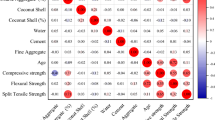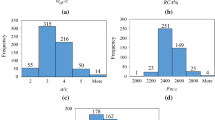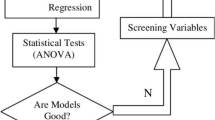Abstract
One of the most fundamental developments in improving the mechanical properties of concrete is the introduction of recycled coarse aggregate, which offers an environmentally preferable substitute for traditional waste management techniques. Using recycled coarse aggregate and a small number of mix proportions for the concrete components, a few studies looked at the mechanical properties of concrete. To assess the impact of recycled coarse aggregate on the long-term compressive strength of concrete at various mix proportions and different compressive strength ranges, this study analyzed four models, including linear regression (LR), nonlinear regression (NLR), pure quadratic (PQ), and full quadratic (FQ). Three datasets training, testing, and validating, each containing 314 data points culled from various studies, were used to apply the models. The recycled coarse aggregate (RA) density ranged from 0 to 1240 kg/m3, and the curing time (t) varied from 1 to 90 days. While the predicted compressive strength of the models ranged between 5 and 75 MPa, the compressive strength of the data gathered from the experimental work of several studies ranged from 8 to 78 MPa. The models’ accuracy was assessed using several metrics, including the coefficient of determination (R2), the root-mean-square error (RMSE), the scatter index (SI), the objective (OBJ), and the mean absolute error (MAE).
















Similar content being viewed by others
Data availability
The data supporting the conclusions of this article are included in the article.
Abbreviations
- LR:
-
Linear regression
- NLR:
-
Nonlinear regression
- PQ:
-
Pure quadratic
- FQ:
-
Full quadratic
- R2 :
-
Coefficient of determination
- MAE:
-
Mean absolute error, MPa
- SI:
-
Scatter index, MPa
- RMSE:
-
Root-mean-square error, MPa
- OBJ:
-
Objective function, MPa
- w/c:
-
Water/cement ratio
- CC:
-
Cement content, kg/m3
- SC:
-
Sand content, kg/m3
- NA:
-
Natural aggregate, kg/m3
- RA:
-
Recycled aggregate kg/m3
- RAR:
-
Recycled aggregate replacement, %
- NAR:
-
Natural aggregate replacement, %
- SP:
-
Superplasticizer, %
- t:
-
Curing time, day
- CS:
-
Compressive strength, MPa
References
Bairagi N, Ravande K, Pareek V. Behaviour of concrete with different proportions of natural and recycled aggregates. Resources Conser Recycl. 1993;9(1–2):109–26.
Kharrufa S. Reduction of building waste in Baghdad Iraq. Building Environ. 2007;42(5):2053–61.
Nsaif BM. Development BIM model to manage the demolition waste in Iraqi construction projects. Diyala J Eng Sci. 2020;13(2):93–8.
Fathifazl G, Abbas A, Razaqpur AG, Isgor OB, Fournier B, Foo S. New mixture proportioning method for concrete made with coarse recycled concrete aggregate: Journal of Materials in Civil Engineering. J Mater Civil Eng. 2009. https://doi.org/10.1061/(ASCE)0899-1561(2009)21:10(601).
Ali R, Muayad M, Mohammed AS, Asteris PG. Analysis and prediction of the effect of Nanosilica on the compressive strength of concrete with different mix proportions and specimen sizes using various numerical approaches. Struct Concrete. 2022. https://doi.org/10.1002/suco.202200718.
Shi C, Li Y, Zhang J, Li W, Chong L, Xie Z. Performance enhancement of recycled concrete aggregate–a review. J Cleaner Prod. 2016;112:466–72.
Ul Rehman M, Rashid K, Ul Haq E, Hussain M, Shehzad N. Physico-mechanical performance and durability of artificial lightweight aggregates synthesized by cementing and geopolymerization. Construct Building Mater. 2020;232:117290.
Behera M, Bhattacharyya S, Minocha A, Deoliya R, Maiti S. Recycled aggregate from C&D waste & its use in concrete–a breakthrough towards sustainability in the construction sector: a review. Construct Building Mater. 2014;68:501–16.
Al-Saffar IM, Al-Tameemi OA. Technological strategies for recycling concrete block in Iraq. In J Phys. 2021. https://doi.org/10.1088/1742-6596/1973/1/012090.
Mehta PK, Meryman H. Tools for reducing carbon emissions due to cement consumption. Structure. 2009;1(1):11–5.
Ali B, Fahad M, Mohammed AS, Ahmed H, Elhag AB, Azab M. Improving the performance of recycled aggregate concrete using nylon waste fibers. Case Stud Constr Mater 2022;17:e01468.
Oikonomou N. Recycled concrete aggregates. Cement and Concrete Compos. 2005;27(2):315–8.
McNeil K, Kang THK. Recycled Concrete Aggregates: A Review. Int J Concrete Struct Mater. 2013;7(1):61–9.
Manzi S, Mazzotti C, Bignozzi M. Short and long-term behavior of structural concrete with recycled concrete aggregate. Cement Concrete Compos. 2013;37:312–8.
Bosoaga A, Masek O, Oakey JE. CO2 Capture technologies for cement industry. Energy Procedia. 2009;1(1):133–40.
Nayana AY, Kavitha S. Evaluation of C02 emissions for green concrete with high volume slag, recycled aggregate, recycled water to build eco environment. Int J Civ Eng Technol. 2017;8:703–8.
Xuan D, Zhan B, Poon CS. Durability of recycled aggregate concrete prepared with carbonated recycled concrete aggregates. Cement Concr Compos. 2017;84:214–21.
Xiao J. Recycled aggregate concrete. In: Recycled aggregate concrete structures springer tracts in civil engineering. Heidelberg: Springer; 2018.
Abid SR, Nahhab AH, Al-aayedi HK, Nuhair AM. Expansion and strength properties of concrete containing contaminated recycled concrete aggregate. Case Stu Construct Mater. 2018;9:e00201.
Asteris PG, Skentou AD, Bardhan A, Samui P, Pilakoutas K. Predicting concrete compressive strength using hybrid ensembling of surrogate machine learning models. Cement Concrete Res. 2021;145:106449.
Yang C, Feng H, Esmaeili-Falak M. Predicting the compressive strength of modified recycled aggregate concrete. Struct Concrete. 2022. https://doi.org/10.1002/suco.202100681.
Alakara EH, Nacar S, Sevim O, Korkmaz S, Demir I. Determination of compressive strength of perlite-containing slag-based geopolymers and its prediction using artificial neural network and regression-based methods. Constr Building Mater. 2022;359:129518.
Song H, Ahmad A, Farooq F, Ostrowski KA, Maślak M, Czarnecki S, Aslam F. Predicting the compressive strength of concrete with fly ash admixture using machine learning algorithms. Constr Building Mater. 2021;308:125021.
Moradi MJ, Khaleghi M, Salimi J, Farhangi V, Ramezanianpour AM. Predicting the compressive strength of concrete containing metakaolin with different properties using ANN. Measurement. 2021;183:109790.
Pazouki G, Golafshani EM, Behnood A. Predicting the compressive strength of self-compacting concrete containing class F fly ash using metaheuristic radial basis function neural network. Str Concrete. 2022;23(2):1191–213.
Gupta T, Rao MC. Prediction of compressive strength of geopolymer concrete using machine learning techniques. Str Concrete. 2022;23(5):3073–90.
Wang Q, Wang YY, Geng Y, Zhang H. Experimental study and prediction model for autogenous shrinkage of recycled aggregate concrete with recycled coarse aggregate. Constr Building Mater. 2021;268:121197.
Ghorbel E, Wardeh G. Influence of recycled coarse aggregates incorporation on the fracture properties of concrete. Constr Building Mater. 2017;154:51–60.
Corinaldesi V. Mechanical and elastic behaviour of concretes made of recycled-concrete coarse aggregates. Constr Building Mater. 2010;24(9):1616–20.
Ahmed SEH. Use of Recycled Concrete as Coarse Aggregate for High Strength Concrete (Doctoral dissertation, Sudan University of Science and Technology). 2019.
Rashid K, Rehman MU, de Brito J, Ghafoor H (2020) Multi-criteria optimization of recycled aggregate concrete mixes. Journal of Cleaner Production 276: 124316. https://www.sciencedirect.com/science/article/abs/pii/S0959652620343614
Mahmood W, Khan AUR, Ayub T. Mechanical and durability properties of concrete containing recycled concrete aggregates. Iran J Sci Technol Transact Civil Eng. 2021;46(3):2111–30.
Corinaldesi V, Letelier V, Moriconi G. Behaviour of beam–column joints made of recycled-aggregate concrete under cyclic loading. Constr Building Mater. 2011;25(4):1877–82.
Yi ST, Yang EI, Choi JC. Effect of specimen sizes, specimen shapes, and placement directions on compressive strength of concrete. Nuclear Eng Design. 2006;236(2):115–27.
Ghafor K, Ahmed HU, Faraj RH, Mohammed AS, Kurda R, Qadir WS, Mahmood W, Abdalla AA. Computing models to predict the compressive strength of engineered cementitious composites (ECC) at various mix proportions. Sustainability 2022;14(19):12876.
Funding
This work had no funding.
Author information
Authors and Affiliations
Corresponding author
Ethics declarations
Conflict of interest
The authors declare that they have no competing interest.
Ethical approval
Not applicable.
Consent to participate
Not applicable.
Additional information
Publisher's Note
Springer Nature remains neutral with regard to jurisdictional claims in published maps and institutional affiliations.
Rights and permissions
Springer Nature or its licensor (e.g. a society or other partner) holds exclusive rights to this article under a publishing agreement with the author(s) or other rightsholder(s); author self-archiving of the accepted manuscript version of this article is solely governed by the terms of such publishing agreement and applicable law.
About this article
Cite this article
Ibrahim, A.K., Dhahir, H.Y., Mohammed, A.S. et al. The effectiveness of surrogate models in predicting the long-term behavior of varying compressive strength ranges of recycled concrete aggregate for a variety of shapes and sizes of specimens. Archiv.Civ.Mech.Eng 23, 61 (2023). https://doi.org/10.1007/s43452-022-00595-2
Received:
Revised:
Accepted:
Published:
DOI: https://doi.org/10.1007/s43452-022-00595-2




